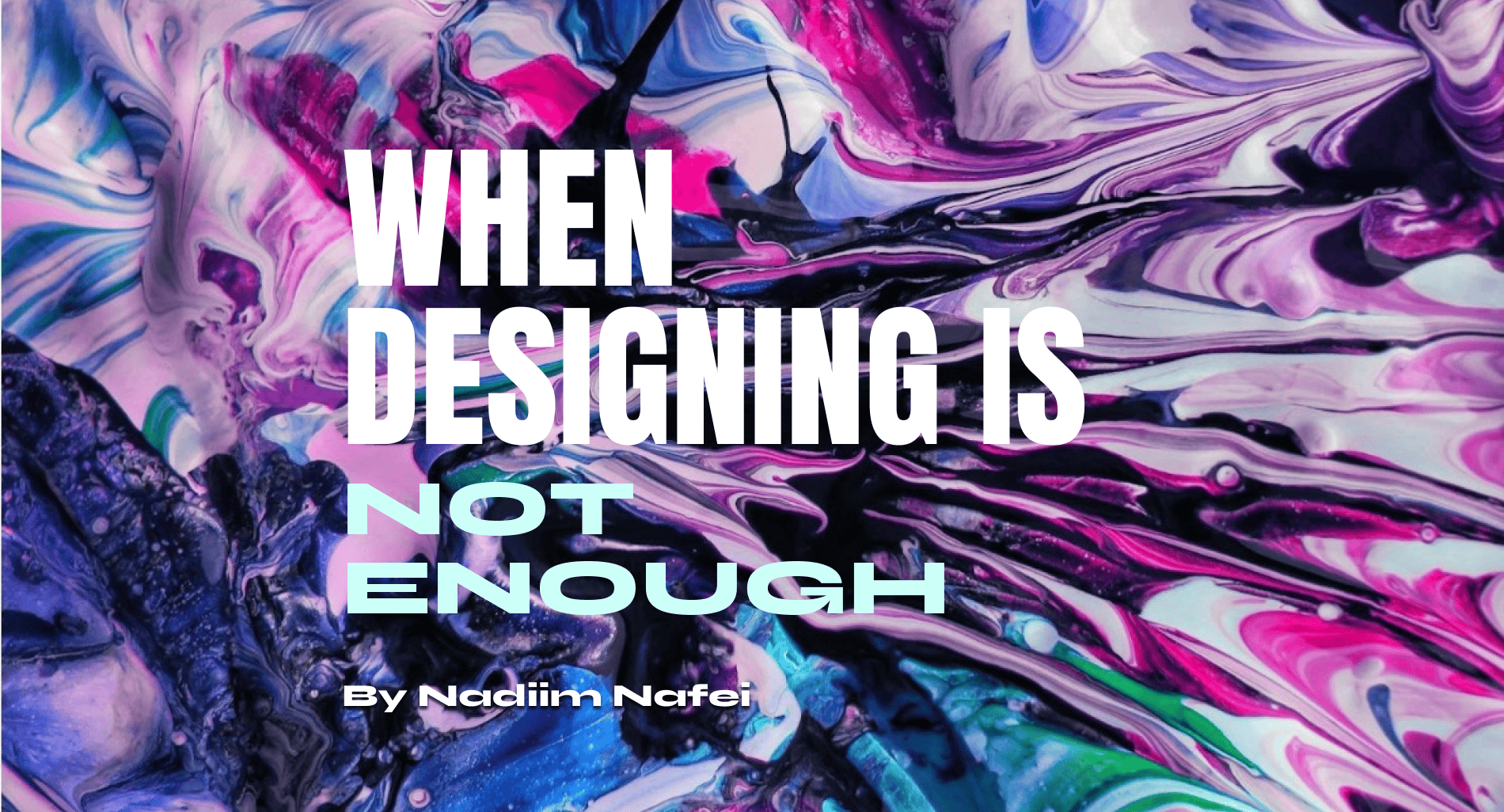Have you ever felt that your role as a designer wasn’t being appreciated? Like your stakeholders weren’t listening? That you weren’t given the appropriate space to do your job and do it well? I have—many times. Unfortunately, this experience is far too familiar among designers. Despite their critical contributions, designers often find their roles simplified as “make pretty”.
Don’t get me wrong, for many designers, being an individual contributor (IC) specializing in developing something beautiful, pleasing and desirable is what got them into design in the first place and what they continue to love about their work as designers. Historically, this has been a role design has held well, especially in fields like interior and fashion, where aesthetics has been vital. Today, design is involved in almost every corner of the industry as interaction has become more digital, and the designer’s role has expanded as the need for better, more user-focused and holistic solutions has increased. And to many who see their skills and roles as larger than “developers of aesthetics”, the role of an IC feels like it’s limiting them from doing great work.
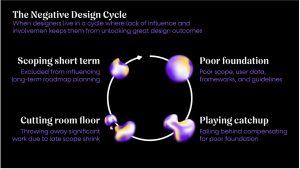
As a consequence, designers aren’t always given the appropriate space to operate in, and they often find themselves in a vicious cycle of playing catchup (Figure 1): At first, struggling with mediocre data or frameworks to base their work on and then fighting for more time to do user research compensating for the lack of foundational data. After the resulting project delays or the inevitable shifts in resource allocation, designers battle with product management over which part of the design should be dropped to get back on track. Later, when designers lobby for influence in (strategic) planning and decision-making to better scope the design effort, they get rejected, and so the story repeats itself over and over.
Part 1: Why designers are misunderstood
But why is the designer’s role so undervalued and their potential so underutilized? This topic has always been of particular interest to me throughout my career, but I wanted to see how my own experiences compare with those of others. So, I interviewed a dozen designers across various industries and design fields to learn more.
I found many commonalities behind why designers might be misunderstood in their organizations, but more importantly, I also learned a lot about how designers can take steps to change it. Let’s dive into a few of the big ones.
Ownership conflicts
One of the most common frustrations I hear designers face is the need for more clarity around their role. Part of the designer’s role is often to “improve the user experience.” Still, they find themselves at odds with other teams—marketing, sales, product owners, or even engineers/developers—who gatekeep the user (Figure 2). So, who owns the user and the user experience?
In many organizations, sales or marketing often own the customer and their needs. In the growing segment of product-led growth organizations (PLG)[1], however, they might be owned by product management. The customer needs are then passed on to the designer as part of a project brief for them to build their design based on—if the designers are lucky enough to get any insight at all.
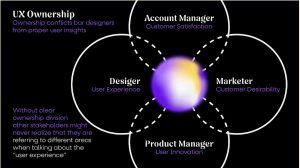
Part of the problem is that the (commercial) customer needs are equated to user needs and -experience. So when designers lobby for more involvement in customer visits or user interviews, other teams might interpret this as designers encroaching on their responsibilities or even undermining their authority. This fosters conflict and pushback, blocking designers from participating in user research, let alone defining what insights to prioritize or how those insights are defined and gathered.
Through their “UX-Maturity Model”, Nielsen Norman Group (NN/g) describes the degree of UX implementation in an organization in six stages, from “Absent” to “User-Driven” (Figure 3), highlighting strengths and weaknesses at each stage[2]. Here, tension in UX ownership and responsibilities, inconsistent UX prioritization and lack of support from leadership are prevalent throughout stages 3 and 4. These stages are also described as “dangerous” [3] because organizations think they are now “doing UX” and have a user-driven approach because they do usability tests and have dedicated UX roles. However, this becomes a false-positive crutch, preventing organizations from creating adequate user-driven structures and strategies, and thus, they fail to leverage their designers.
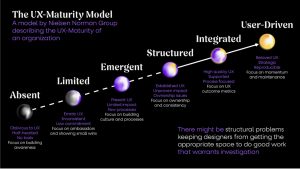
In these types of organizations, on the lower two-thirds of the UX-Maturity Model, design is still seen as a service to other teams rather than a strategic partner. If designers don’t have clear (co)ownership of the user experience, their input often carries less weight and becomes one among many. When designers aren’t empowered to drive decisions, they’re left trying to justify their worth on the fringes of the process, and the design outcomes suffer.
Impact without measure
Another common reason designers and their work are often undervalued is that we often talk about the importance of design implicitly and in design terms and expect non-designers to understand (Figure 4). However, without concrete or quantifiable metrics tied to design work, showing its value and impact in a language that resonates with high-level stakeholders becomes difficult, even if they already have an appreciation for it.
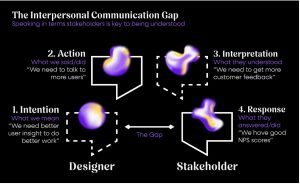
When we fail to show the value of our work, we leave room for others to undervalue or misinterpret our contributions. The depth of what a designer brings—improved user engagement, smoother workflows, increased conversions, increased customer satisfaction—is lost in the conversation. In turn, lobbying for more involvement, ownership, resources, and whatever else might be lacking for the design team to maintain or expand their influence and improve their potential to do great work becomes much more challenging—continuing the vicious cycle of underappreciation.
Part 2: How designers can improve their standing
The good news? Designers don’t have to stay in this cycle. There are ways to improve our standing in organizations, get heard, and have more control over our work. It won’t happen overnight, but with a few mindset shifts, there are ways to change it. Let’s look at some of them.
Stop asking for permission
I often see designers being somewhat passive and averse to conflict. They fear creating friction between teams, so they wait for permission to step outside the predefined boundaries, afraid to step on somebody’s toes. We tend to think, “If only they saw how valuable I or ‘this thing’ could be, they’d give me more influence.” The problem is, if we’re always waiting for others to recognize our potential worth, we might be waiting forever for an opportunity to prove it.
Instead of waiting for permission to, e.g., have more ownership of UX, designers should take responsibility for their role on their terms. If you see an opportunity to create value outside just developing aesthetics—whether it’s improving user flows, refining processes or systems, or gathering proper insights—do a side- or test project, put in a few more hours, whatever you need, just do it.
What I have seen is that once you can demonstrate results and what good design can achieve outside the role of “make pretty,” opportunities to expand your ownership will come more naturally, and asking for forgiveness will become irrelevant. Later, this could even be more formalized properly as part of your Roles and Responsibilities, either as a designer or team.
Quantify your impact
Finding metrics relevant to the value you want to demonstrate and a suitable way to measure them is essential.
Key Performance Indicators (KPIs) are usually used in commercial teams and tied directly to commercial goals such as increased revenue. However, they might not be the best method to evaluate design outcomes. Some product organizations favor using Objectives and Key Results (OKRs) for engineers as well as designers. But who defines the OKRs? Are they specific enough to show the particular impact of design, or does the designer’s role drown in broad objectives applied to the whole product team?
Whether your team or organization has established goals or success indicators, designers should never hesitate to create their own. One simple way to start quantifying your impact as a designer or design team is to think of impact as achievements in numbers (Figure 5).
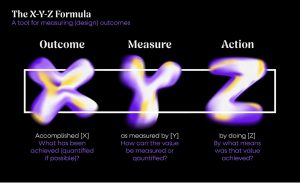
This method, called the X-Y-Z Formula, is often used in recruiting[4] to discuss the applicant’s accomplishments but can also be used as a simple framework to communicate the impact and value design can bring in terms easily understood across the organization. Did you “improve the usability of the sign-up process”? Or did you “Minimize sign-up drop-offs by reducing sign-up steps by 80%, through integrating automation in sign-up user flow”—a banal example perhaps, but you get the gist. It quantifies what value you or the design team just brought after all those months of work; of course, it would be even better if you could put a number on just how much drop-offs have been reduced by and over how long of a period. Does your organization have clear reasons to be, e.g. mission, vision, etc? Formalized company strategies? Defined Must-Win-Battles? Tying your efforts back to the big picture is an even better way to prove the value of design and communicate that your work is helping steer the ship in the right direction.
If designers want more influence and ownership, we need to start framing our contributions in terms of metrics that resonate with stakeholders. That might sometimes mean learning to tie our work directly to things like increased conversions, reduced customer support tickets, or faster product adoption. Management may not always understand design theory, but they do understand results.
Designing Your Future
At the end of the day, being a designer is about much more than just aesthetics. Designers are sense-makers, problem-solvers, systems thinkers, user advocates, and more. But to truly fulfill that potential, we need to step up and demonstrate and communicate our value in terms that resonate across the business.
By gathering the courage to take matters into our own hands, showing the value of our work through tangible results, and quantifying our successes, we can change the perception of design in our organizations and carve out a seat at the table. It’s not about just being heard—it’s about being understood.
The future of design in business is bright, but it’s up to us to shape that future. So the next time you feel undervalued or unheard, take a step back and ask yourself: how can I demonstrate the value of what I bring? Because design matters, and so do you—it’s time to make sure everyone else knows it, too.
* * *
Do you want to hear more from Nadiim? He will host a workshop at the digital design conference Design Matters 24. Connect with Nadiim on LinkedIn
Sources
[1] https://amplitude.com/blog/product-led-growth
[2] https://www.nngroup.com/articles/ux-maturity-model/
[3] (1:00 – 1:36) https://www.nngroup.com/videos/six-levels-of-ux-maturity/


